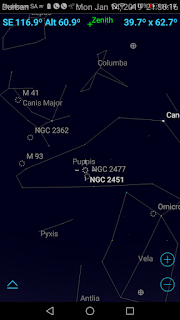The weeks seem to have flown by and here we are with only a few days left for January 2019.
The weather in Durban has not cooperated and this astronomer has not seen any stars through a scope, I did manage two short binocular session though, just enough to keep the withdrawal shakes at bay.😟
So let's take a brief look at what the remainder of January and early February have to offer.
MOON AND PLANETS.
On the evening of the 27th Jan the Moon will be at last quarter and will rise shortly before midnight.
Jupiter starts to rise earlier now and is visible from 01H30 in the mornings.
Venus rises at 02H00 and together with Jupiter put on an impressive early morning display.
Saturn starts to make a early morning return and is up from 03H34.
Mars is still visible to the naked eye in the early evenings in the western skies, it dips below the horizon at 22H20.
Venus will reach it's highest point in it's 2018-2019 morning apparition on the 2nd Feb. From Durban it will reach a maximum elevation above horizon of 41° at sunrise.
We see several conjunctions this week. When two objects share the same right ascension we refer to this as a conjunction.
On the 31st Jan, the Moon and Jupiter are at conjunction, the two will be passing within 2°43' of each other.
The Moon and Venus are at conjunction on the 31st, the pair will pass within 0°05' of each other.
The Moon and Saturn pass within 0°37' of each other on the morning of the 2nd Feb.
All these will be visible from 02H00 onward.
 | ||
| Jupiter, image courtesy NASA. |
DEEP SKY OBSERVING (DSO).
Lets take a look at two of the biggest globular clusters visible in the night skies.
Omega Centauri and Tuc 47. These will both be easily visible before the Moon rises and starts to interfere with any DSO observing, although both do stand up well to even a full Moon.
Omega Centauri, NGC 5139, globular cluster in Centaurus, Magnitude +3.68.
This is the largest and brightest globular cluster in our night skies. From darker skies it is a naked eye object.
From our light polluted backyards it is a easy binocular target and even more spectacular through the scope. Many thousands of stars greet your eye through the eyepiece, with a bright dense core surrounded by a profusion of stars extending out in a large ball.
 |
| Omega Centaurus, NGC 5139. |
NGC 104, TUC 47, Globular cluster in Tucana, Magnitude +3.95.
The second brightest and largest behind NGC 5139. A easy binocular target and a great scope target.
This cluster also presents thousands of stars in the scope with a smaller overall size and brightness than NGC 5139 but it still packs a punch, especially under dark skies.
 |
| NGC 104, TUC47 |
INTERNATIONAL SPACE STATION (ISS).
The space station makes several passes over Durban this week and will be visible from all over South Africa.
These all occur in the very early morning hours just before sunrise, so you early risers will be best placed to catch the station as it sails overhead.
 |
| ISS, image courtesy NASA. |
The above table is taken from spot the station. All the dates and times above are for Durban South Africa, they also apply to the rest of South Africa.
To find the exact times for your location check out the "spot the station" link in the "quick links" tab on the right column of this blog.
____________________________________________________
So that wraps up some of the highlights to take in this week. While there are many more I have only highlighted those that are easy to locate and view. Feel free to share this post on social media using the buttons below this post.
Thanks for reading and get out there and look up!




















